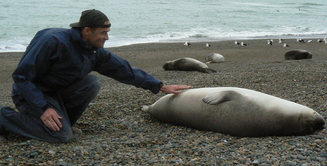Professor Rory Wilson
The core impact of the case study is the popularisation and dissemination of information on animal movement and migrations to over 330 million people around the world (reaching 166 countries and in 34 languages) via the National Geographic TV portal consisting of 7 hour-long episodes, in addition to six books for both children and adults, maps, mobile apps, retail products, a DVD and an educational curriculum. This undertaking follows 2.5 years filming in the field on all continents and travel of over 420,000 miles in National Geographic’s global initiative, the largest in its 122-year history.
The contribution, impact and benefit
Rory Wilson, at Swansea University since 2004, was initially awarded a Rolex Award for Enterprise (2006), which facilitated the development and testing of the proposed tag. The proposition for the tag has resulted in a number of companies worldwide emulating it to sell to the biological community (e.g. http://cats.is/index.php option=com_content&view=article&id=12 and http://www.wildlifecomputers.com/). To date, a total of 45 peer-reviewed publications document the advances in methods, ethical issues and animal understanding that have resulted from this approach, all stemming from RPW and Swansea University (see http://scholar.google.co.uk/citations?hl=en&user=CZkZV88AAAAJ&oi=sra).
The airing of ‘Great Migrations’ as a seven-part (7 X one-hour documentaries) series showed National Geographic’s high definition coverage of animal migrations around the globe. This work, the biggest in National Geographic’s 124-year history, was premiered worldwide on 7th October 2010 to an estimated audience of 330 million people from 166 countries (translated into 34 different languages). The response to the series was very positive.

